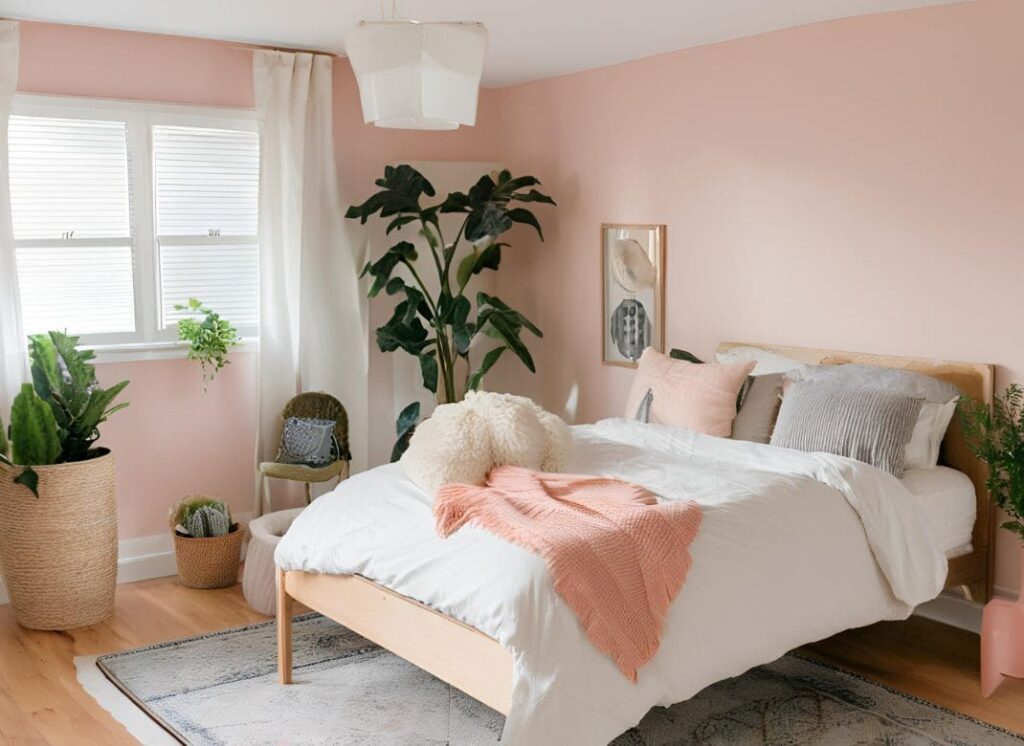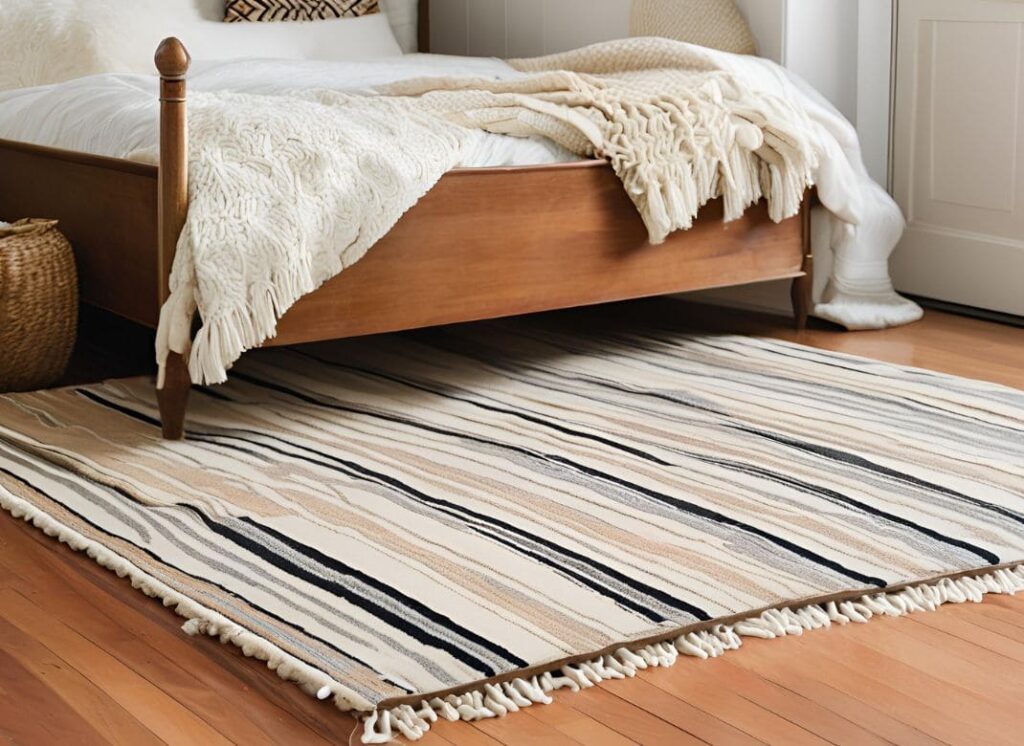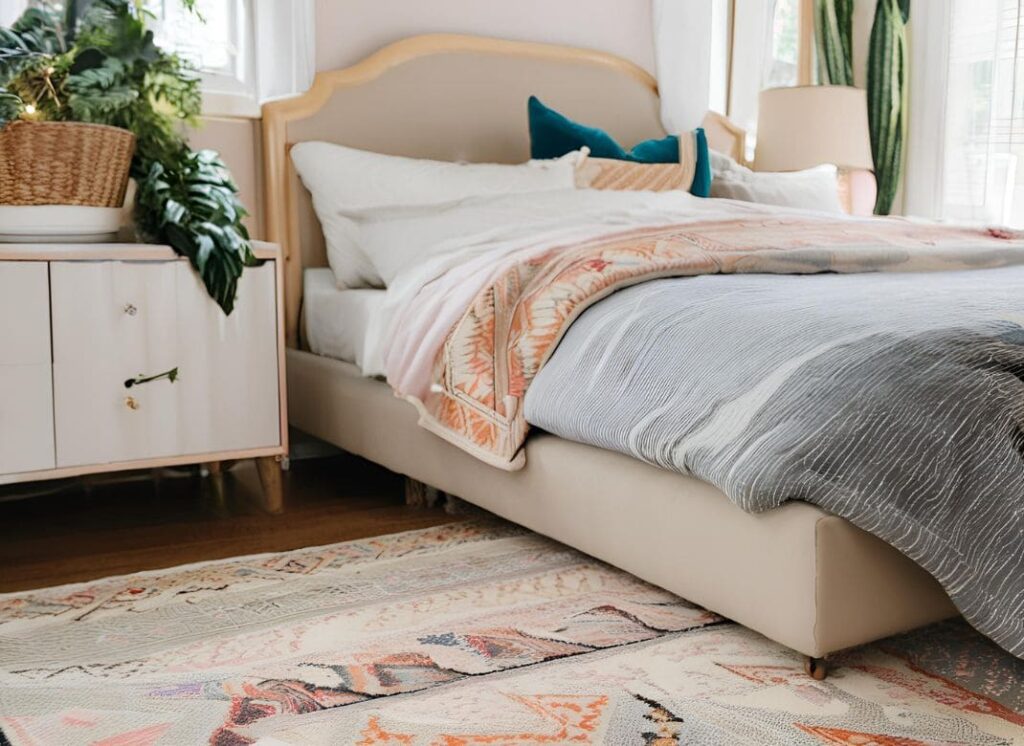
Putting a rug in your bedroom adds softness, personal style, and color. Rug placement under bed, it makes the bed stand out as the room’s main focus. A rug under the bed has many benefits, but you also need to think about layout, size, and scale.
Common rug placement under bed in bedroom-related terms
Before buying a bedroom rug, it’s helpful to know some common rug terms. Understanding these terms will make it easier to research your options.
Backing: the fabric on the back of a rug that keeps its shape. Not all rugs have backings, depending on how they are made.
In This Post
TogglePile: the height of the raised surface of the rug. A higher pile means a plusher and thicker rug. Be careful with high-pile rugs, as they might not fit under doors.
Warp: the vertical yarns in a woven rug.
Weft: the horizontal yarns woven through the warp in a woven rug.
Yarn: The single strand of material used in weaving to create the rug’s fibers.
The right size of rug for rug placement under bed
Consider bed frames and nearby furniture.
When choosing a rug, think about your bed frame size and how nearby furniture will fit on it.
Use a Large Rug for a King-Size Bed
A king-size bed is 76 by 80 inches. A 9 x 12-foot rug works well, extending under the nightstands and around the bed. If you have space at the end of the bed, you can expose more of the rug. You can also opt for a 12 x 15-foot rug for extra coverage.
Try a medium-to-large rug for a queen-size bed.
A queen-size bed is 60 by 80 inches. An 8 x 10-foot rug extends 18 inches from each side and covers the foot of the bed. For more coverage, go with a 9 x 12-foot rug. You can also use a round rug placed two-thirds under the bed.
Get Lots of Options With a Full-Size Bed
A full-size bed is 54 by 75 inches. An 8 x 10-foot rug fits well, covering the nightstands and extending beyond the bed. An 8-foot round rug can also work if it extends under the bed to the nightstands.
Anchor twin beds as you like.
A twin bed is 39 by 75 inches. An 8 x 10-foot rug fits nicely with space for a nightstand. For two twin beds, an 8 x 10-foot rug might not cover both sides, so consider a 9 x 12-foot or 12 x 15-foot rug for better coverage. You can also use two separate round rugs for added style.

Anatomy of Your Bedroom Area Rug
Rugs help tie your home decor together, and rug placement under bed balance when you use right size of rug. Since they surround your bed, which is the main focus of most bedrooms, they are very important in your design.
You have to include a rug pad.
If you weren’t happy with how rugs worked before, it might be because you didn’t have the right rug or rug pad. Rug pads give extra cushioning, making your feet feel comfortable. A flat-woven herringbone rug feels nicer with a pad underneath.
Rug pads also stop your rug from slipping or bunching up. If you want grip without padding, try gripper tape on the bottom of your rug, especially around the edges.
Get the Right Rug for Your Bedroom
- Think about what you need from your rug and your bedroom space before choosing one.
- It can protect the floor from furniture or spills.
- It can show off your personal style.
- It can anchor the room’s decor and highlight the main focus.
- It can cover dull carpeting or floor imperfections.
- It can reduce echoing sounds.
- It can add comfort and keep your feet warm at night.
Know about rug fiber types for the bedroom.
The rug you choose for your bedroom might not be the same as what you’d pick for your living room or dining room. Bedroom rugs don’t get as much wear or spills, though occasional late-night spills can happen.
Extra plush rugs, like flokati or shag rugs, can be hard to clean, especially with pets. Choosing a washable and natural rug that’s easy to care for is a good idea.
Choose a rug shape based on the bedroom shape.
A good rule for choosing the right rug size is to match its shape and size to your bedroom. For a small, square bedroom, a square rug works well. For a larger rectangular room, a rectangular rug will create a balanced look.

Consider your rug placement.
Before choosing a rug size, think about where you want to place it and the look you prefer. Designers often suggest having at least 24 inches of rug around the edges of your bed for balance, but feel free to adjust this rule to suit your style.
Consider this advice along with your bed and room dimensions. For a clearer idea of how a rug will fit, use Spoak’s layout tool to visualize your space.
A Rug That Covers the Entire Room
If you want a rug that gives you all the benefits of an under-bed rug and also covers flooring you don’t like, choose a large rug that covers the whole room. Make sure there are two to five inches of bare floor showing around the edges and that all doors can open over the rug without catching.
If you’re worried about where to put your bedroom furniture, don’t be:
- Your nightstands can sit on the rug with two to three inches of rug extending on each side.
- Place the dresser at least six to twelve inches away from the rug to keep the look balanced.
Let your rug embrace only the bed.
If your rug runs under the entire bed, make sure it extends enough from the sides so you can make the bed and step into your slippers without leaving the soft rug.
Place Your Rug Under Two-Thirds of the Bed
For a balanced look, use the rule of thirds. Place a smaller rug under the bottom two-thirds of the bed, with the rug’s edge within six inches of the front of your nightstands. This way, more of the rug will show at the foot of the bed, and your bench will fit nicely on it.
Layer Rugs for Depth and Texture
Layering rugs adds texture and contrast. For example, you can soften a rugged jute rug with a plush Moroccan print rug on top. Let two to three inches of the base rug show around the edges of the top rug.





